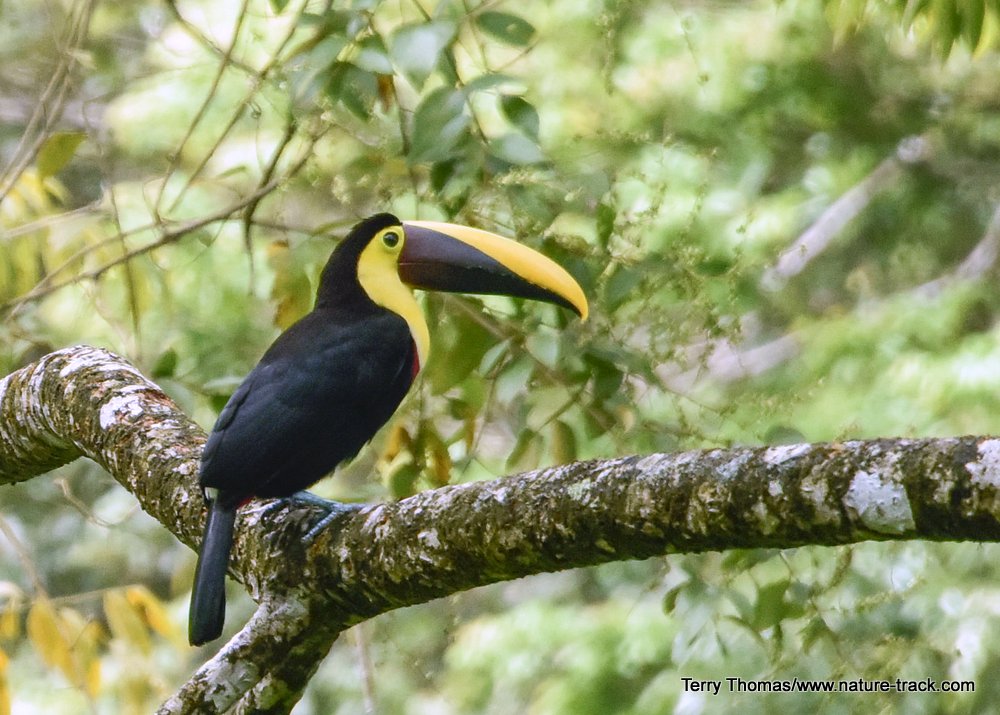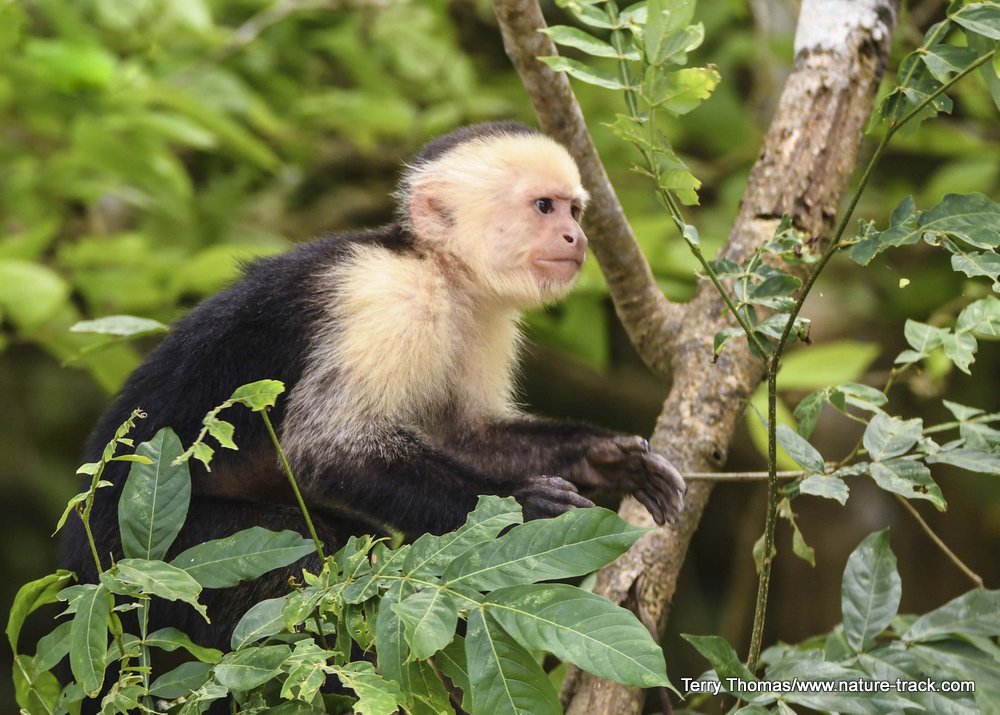Costa Rica

A chestnut-mandibled toucan along a forested road in Costa Rica.
We just completed our first trip to a foreign country, Costa Rica, in six years. Several friends asked us, “Why Costa Rica?” I was dumbfounded. Costa Rica is awesome: with only 0.03 percent of the Earth’s landmass, has five percent of the biodiversity, including 12,000 species of plants, 910 species of birds (more than the U.S. and Canada combined), 1,549 species of butterflies, 226 reptile and 196 amphibian species and 240 species of mammals. Costa Ricans are justifiably proud of that status and are anxious to share it. Who wouldn’t want to go there?
Costa Rica is a small but beautiful country in Central America, bordered by Nicaragua on the north and Panama on the south (or east). Half the size of the state of Kentucky, it boasts both Pacific and Atlantic (Gulf of Mexico) shores. It runs nearly parallel to the equator and just miles from it. Daylight and nighttime hours are almost split evenly year-round. It is largely a tropical climate with a wet season and a dry season. Eighteen feet of rain fall annually in some of the wettest forests along their continental divide. The south half of the country was formed by the collision of tectonic plates and still counts 7,000 tremors a year. The northern half was built by volcanoes and active volcanoes still dot the landscape.
Tourism is the number one economic driver in Costa Rica. The tour company we used starts two busloads of tourists on an eight day tour every single day during the dry season, and about a third of that during the wet season. They are only one of many tour companies that offer everything from laidback tours like ours to specialized high adventure and photography tours.
Tourism is popular in part because of Costa Rica’s commitment to conservation of natural resources. Over ten percent of the country is protected by national parks. Another seventeen percent is protected as natural areas, biological reserves or wildlife refuges. Costa Rica is the first country to intentionally practice reverse deforestation. In the past 30 years or so, forested areas have almost doubled in size.
I was pretty excited to get to Costa Rica and just wander around a bit with my camera and binoculars. However, an accident two days before departure left my right arm in a sling and me hobbling around very slowly with a cane for support. My trip changed dramatically. I wondered if I would really be able to experience anything meaningful.
It didn’t take long allay my fears. Birds and animals, it seemed, were everywhere. Hotel gardens, bus rides, sitting on a beach or lounging around the pool could yield a surprise visit from an iguana, a sloth, monkeys or new birds. Two river boat tours and a visit to Manuel Antonio National Park helped to fill our wildlife dance card as well.
While we did see a few species that we can see here (after all some of our birds spend their winters there) such as the great blue heron and white-tailed deer (the symbol of Costa Rica), by far the animals and birds we saw were new to us. We reveled in seeing toucans, macaws, including the once endangered scarlet macaw, basilisk lizards, crocodiles, three species of monkeys, two species of sloths and a wide range of other birds.
In a word, Costa Rica was stunning. Who would have thought that a small Central American country with no standing army would be willing to make the choices to ensure a future for wildlife, rainforests and their economy while leading the world in conservation?
You can read more and see more photos of our trip by clicking on the image below:
Help Idaho Wildlife
When we traveled across the state in October 2017, we visited most of the Idaho Department of Fish and Game wildlife management areas. Most of the vehicles we saw using the wildlife management areas did not have wildlife plates. Buying wildlife plates is a great way for non-hunters and hunters alike to support wildlife-based recreation like birding.
C'mon folks, let's help Idaho's wildlife by proudly buying and displaying a wildlife license plate on each of our vehicles!
See below for information on Idaho plates. Most states have wildlife plates so if you live outside Idaho, check with your state's wildlife department or vehicle licensing division for availability of state wildlife plates where you live.
And tell them that you heard about it from Nature-track.com!

Wildlife License Plates
Great news! as of 2024, there are three NEW designs for license plates. They still are bluebird, cutthroat trout and elk, but they are beautiful.
Idaho Wildlife license plates provide essential funding that benefits the great diversity of native plants and wildlife that are not hunted, fished or trapped—over 10,000 species or 98% of Idaho’s species diversity. Game species that share the same habitats (such as elk, deer, antelope, sage-grouse, salmon, trout) also benefit from these specialty plates.
No state tax dollars are provided for wildlife diversity, conservation education and recreation programs. Neither are any revenues from the sale of hunting or fishing licenses spent on nongame species. Instead, these species depend on direct donations, federal grants, fundraising initiatives—and the Idaho Wildlife license plates.
Both my vehicles have Bluebird Plates. I prefer the bluebird because the nongame program gets 70 percent of the money from bluebird plates, but only 60 percent of the money from elk and trout plates - 10 percent of the money from elk plates supports wildlife disease monitoring and testing programs (to benefit the livestock industry) and 10 percent from cutthroat plates supports non-motorized boat access.
Incidentally, in 2014, the Idaho Legislature denied the Department of Fish and Game the ability to add new plates or even to change the name of the elk and cutthroat plates (very specific) to wildlife and fish plates, a move that would have allowed for changing images occasionally and generating more revenue. It would seem that they believe that we Idahoans don't want a well funded wildlife program.
I think it is time we let the Legislature know that Idahoan support wildlife funding and that we would like to see these generic plates come to fruition.

"WOW. What a phenomenal piece you wrote. You are amazing." Jennifer Jackson
That is embarrassing, but actually a fairly typical response to my nature essays. Since The Best of Nature is created from the very best of 16 years of these nature essays published weekly in the Idaho Falls Post Register (online readership 70,000), it is a fine read. It covers a wide variety of topics including humorous glimpses of nature, philosophy, natural history, and conservation. Readers praise the style, breadth of subject matter and my ability to communicate complex and emotional topics in a relaxed and understandable manner.
Everyone can find something to love in this book. From teenagers to octogenarians, from the coffee shop to the school room, these nature essays are widely read and enjoyed.
Some of the essays here are my personal favorites, others seemed to strike a chord with readers. Most have an important message or lesson that will resonate with you. They are written with a goal to simultaneously entertain and educate about the wonderful workings of nature. Some will make you laugh out loud and others will bring a tear to the eye and warm your heart.
Readers Write:
"You hit a home run with your article on, Big Questions in Nature. It should be required reading for everyone who has lost touch with nature...great job!" Joe Chapman
"We enjoyed your column, Bloom Where Planted. Some of the best writing yet. The Post Register is fortunate to have your weekly columns." Lou Griffin.
To read more and to order a copy, click here or get the Kindle version
Copies are also available at:
Post Register
Island Park Builders Supply (upstairs)
Barnes and Noble in Idaho Falls
Harriman State Park, Island Park
Museum of Idaho
Valley Books, Jackson Wyoming
Avocet Corner Bookstore, Bear River National Wildlife Refuge, Brigham City, Utah
Craters of the Moon National Monument Bookstore, Arco, Idaho
Wildlife License Plates
Great news! as of 2024, there are three NEW designs for license plates. They still are bluebird, cutthroat trout and elk, but they are beautiful.
Idaho Wildlife license plates provide essential funding that benefits the great diversity of native plants and wildlife that are not hunted, fished or trapped—over 10,000 species or 98% of Idaho’s species diversity. Game species that share the same habitats (such as elk, deer, antelope, sage-grouse, salmon, trout) also benefit from these specialty plates.
No state tax dollars are provided for wildlife diversity, conservation education and recreation programs. Neither are any revenues from the sale of hunting or fishing licenses spent on nongame species. Instead, these species depend on direct donations, federal grants, fundraising initiatives—and the Idaho Wildlife license plates.
Both my vehicles have Bluebird Plates. I prefer the bluebird because the nongame program gets 70 percent of the money from bluebird plates, but only 60 percent of the money from elk and trout plates - 10 percent of the money from elk plates supports wildlife disease monitoring and testing programs (to benefit the livestock industry) and 10 percent from cutthroat plates supports non-motorized boat access.
Incidentally, in 2014, the Idaho Legislature denied the Department of Fish and Game the ability to add new plates or even to change the name of the elk and cutthroat plates (very specific) to wildlife and fish plates, a move that would have allowed for changing images occasionally and generating more revenue. It would seem that they believe that we Idahoans don't want a well funded wildlife program.
I think it is time we let the Legislature know that Idahoan support wildlife funding and that we would like to see these generic plates come to fruition.
